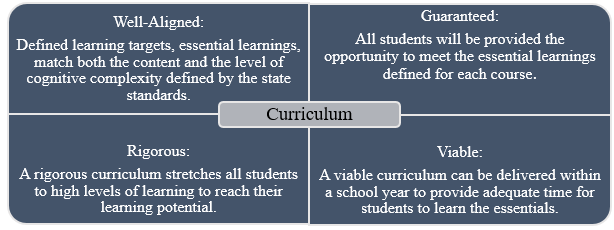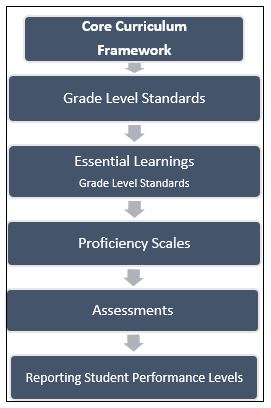Curriculum ~ Assessment ~ Instruction
Big Horn County School District #2 is committed to fostering a differentiated, enriching, educational environment that promotes academic excellence and personal growth for all students. Our focus is on creating a well-rounded curriculum that aligns with state standards while meeting the diverse needs of our students.
Our direction is guided by the principles of equity, engagement, and effectiveness. We work to ensure that every student has access to high-quality instruction and support tailored to their unique learning styles. By leveraging data-driven assessments, we continuously evaluate student performance and instructional strategies, and foster an adaptive learning environment that responds to the evolving educational landscape.
Our primary goals include enhancing student achievement across all subjects, closing achievement gaps, and preparing students for lifelong learning and citizenship. We prioritize professional development for our educators, equipping them with the tools and resources necessary to implement innovative teaching practices that inspire and empower students.
The scope of our curriculum assessment and instruction encompasses a comprehensive approach that integrates academic content, critical thinking, collaboration, and social-emotional learning. We actively involve families and community stakeholders in the educational process, ensuring that our curriculum remains relevant and student centered.
Through ongoing collaboration and reflection, BGH2 aims to create a dynamic and supportive learning environment that prepares all students to thrive in an ever-changing world.
Core Curriculum
Big Horn County School District #2 strives to establish and maintain a well-aligned, guaranteed, rigorous, and viable K-12 curriculum based on the Wyoming Content and Performance Standards.

Curriculum Framework
Wyoming Content and Performance Standards: The state-defined standards provide a foundation for curriculum work. The standards were prioritized using a systematic process which allows for a realistic curriculum expectation within the school year.
Essential Learnings: The essentials represent the learning targets that teachers are expected to address during the instructional year. They are written to provide clarity for teachers, students, and parents. Essentials can represent two levels of learning:
Essentials/Grade Level Standards: These learning targets represent the content and cognitive complexity of the standards. They are designed to define learning expectations in relation to the prioritized standards at the grade/content level. These are the essential learnings that are used to determine proficiency in terms of grade level standards.
Essentials/Pre-Requisite Skills: When appropriate, prerequisite skills are defined that are essential for students to progress through the curriculum. These are below grade level standards and are not used in the core curriculum grading system. ·
Proficiency Scales: The next step in the curriculum framework is the development of proficiency scales. The scales are a continuum that reflects student learning in relation to the essential learnings. The proficiency scales then lead to the development of aligned assessments that provide direct evidence of students’ level of performance.
Assessment: Assessments are developed that provide student opportunity to demonstrate understanding of the essentials. Assessment results are used for classroom grades to document and report levels of student performance.
Targeted Instruction: Teachers use assessment results to determine instructional needs in terms of remediation and/or enrichment. Each school has defined practices for targeted instruction as defined in the MTSS frameworks.
Reporting Student Performance Levels: Levels of student performance for each course are reported through PowerSchool.

The curriculum, assessment, and instruction system at Big Horn #2 is defined within a Multi-Tiered System of Support (MTSS) framework. The MTSS framework has been adapted from the work presented at the PLC at Work Institute (Solution Tree).
BGH2 uses a Professional Learning Community system which puts the work of curriculum, assessment, and instruction into the hands of the principals and teachers. The MTSS Framework serves to answer the four critical questions that guide PLC work.
What do we want our students to know and be able to do?
How will we know if students have learned?
How will we respond if they don’t learn?
How will we respond if they already know it?
Tier 1 represents the core curriculum, aligned to the Wyoming Content and Performance Standards, where all students receive instruction and the opportunity to learn grade level standards. Tier 1 answers the PLC question: What do we want our students to know and be able to do?
The district is committed to ensuring high levels of learning for all students. To best reach this goal, BGH2 has developed a tiered instructional system that defines processes to identify and service students who demonstrate various needs in their learning continuum. The tiered system is designed to meet the needs of all students including those who have not shown evidence of mastery of the grade level essentials as defined in Tier 1, as well as the needs of those students who have exceeded the criteria as defined in the core area.
Tier 2 represents where additional support is provided for students who are academically at risk and need additional intervention to meet grade level learning expectations in and outside of the regular classroom through a differentiated approach to curriculum.
Tier 3 is for those students who need extensive intervention to begin closing the gap towards grade level standards.
Tiers 2 and 3 answer the questions: What is done when students have not demonstrated proficiency on the core curriculum? What is done when students have demonstrated proficiency on the core curriculum?
Assessment
The purpose of the district assessment system is to provide ongoing opportunities for students to demonstrate levels of proficiency in relation to the Wyoming Content and Performance Standards. The State of Wyoming uses this definition of assessment: Assessment is the process of gathering evidence of student learning to inform education-related decisions. The district uses a variety of assessment types to provide this evidence of student learning including: ACT, WY-TOPP, FastBridge, and District Assessments.
Staff
Aryn Tippetts, Curriculum Director, Children and Youth in Transition Liaison Email Aryn Tippetts
William Hiser, Transportation/Human Resources Email William Hiser
Please follow this link to the BGH2 Intervention Processes.
Please follow this link to the BGH2 Curriculum Transparency Documents.
